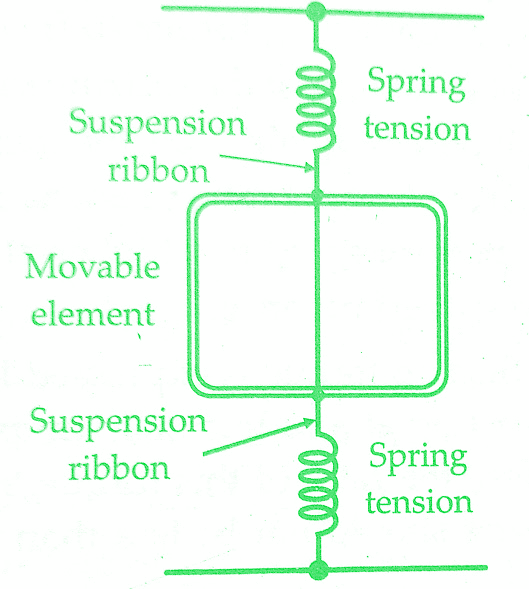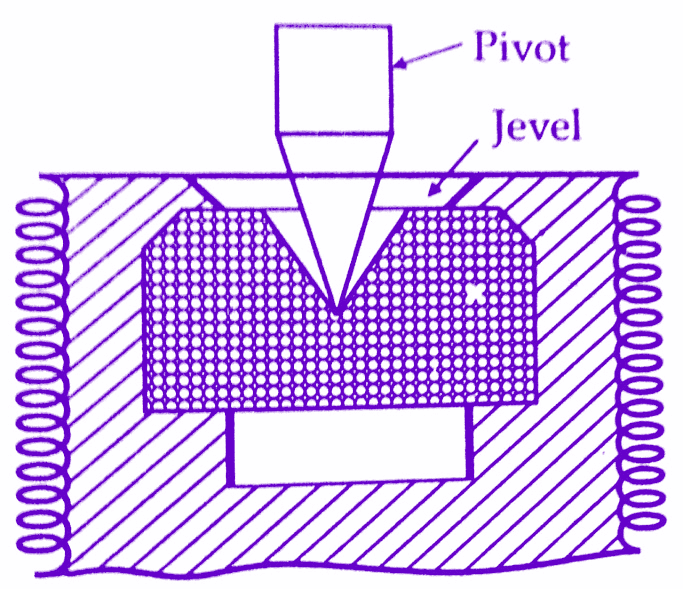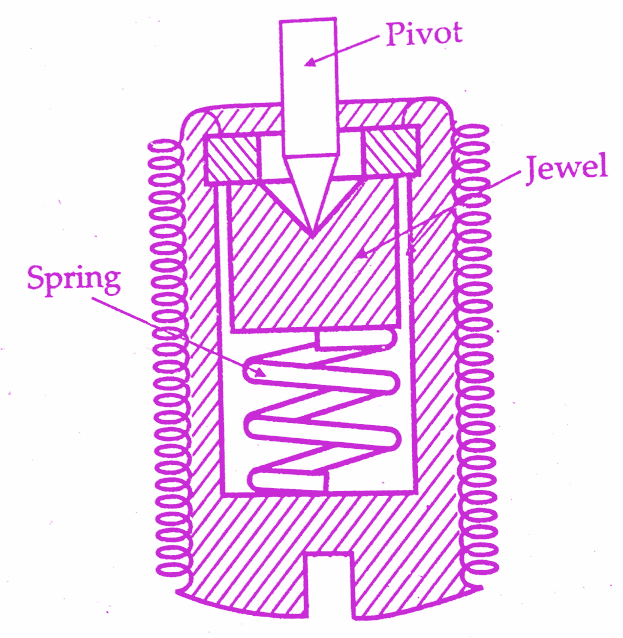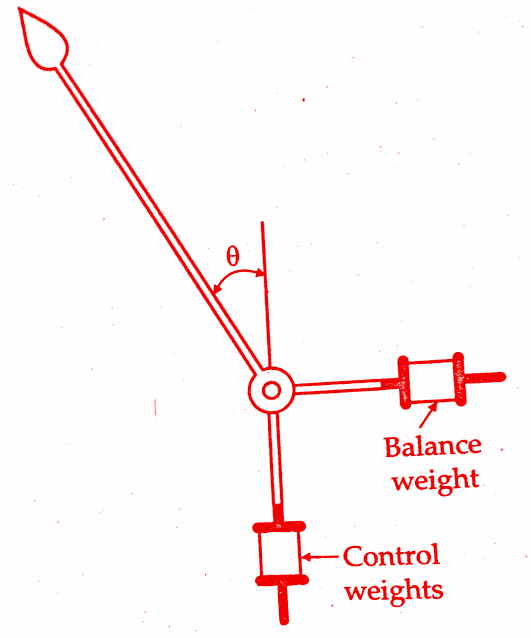As we all know the construction of indicating instruments, these instruments use a dial and a pointer for the magnitude.Three types of forces are needed for the satisfactory operation of any indicating instrument. These are :
(i) Deflecting force
(ii) controlling force
(iii) damping force
Now here let us discuss the role of deflecting torque in indicating instruments.
Deflecting Torque in Indicating Measuring Instruments:
The deflecting torque or operating force is required for moving the pointer from its zero position.The system producing the deflecting force is called “Deflecting system or Moving System”.The deflecting torque can be produced by utilising any of the effects mentioned earlier.Thus the deflecting system of an instrument converts the electric current or potential into a mechanical force called deflecting torque.The deflecting system thus acts as the prime mover responsible for deflection of the pointer.
Constructional details of Deflecting or Moving system:
The requirements of a deflecting system are :
(i) The moving parts should be light
(ii) The frictional forces should be minimum.
These requirements should be fulfilled in order that power required by the instrument for its operation is small.(The power expenditure is proportional to the weight of the moving parts and the frictional forces opposing the movement).The deflecting system can be made light by using aluminium as far as possible.The frictional forces are reduced by using a spindle mounted between jewel bearings and by carefully balancing the system.Supporting the moving element.
The force or torque developed by the moving element of an electrical instrument is necessarily small in order that the power consumption of the instrument be kept low so that the introduction of the instrument into a circuit may cause a minimum change in the existing circuit conditions.Because of low power levels, the consideration of various methods of supporting moving element becomes of vital importance.With the operating forces being small, the frictional forces must be kept to a minimum in order that the instrument reads correctly and is not erratic in action and is reliable.
Must Read:
Types of Supports:
Several types of supports are used, depending upon the sensitivity required and the operating conditions to be met. Supports may be of the following types :
♦ Suspension
♦ Taut Suspension
♦ Pivot and jewel bearings (double)
1.Suspension:
It consists of a fine, ribbon shaped metal filament for the upper suspension and coil of fine wire for the lower part.The ribbon is made of a spring material like beryllium copper or phosphor bronze.This coiling of the lower part of the suspension is done in order to give negligible restraint on the deflecting system.The type of suspension requires careful levelling of the instrument so that the moving system hangs in correct vertical position.
This construction is, therefore, not suited to field use and is employed only in those laboratory applications in which very great sensitivity is required. In order to prevent shocks to the suspension during transit etc. a clamping arrangement is employed for supporting the deflecting system.
2.Taut suspension:
Suspension type of measuring instruments can only be used in a vertical position.The taut suspension has a flat ribbon suspension both above and below the moving element, with suspension kept under tension by a spring arrangement.The advantage of this suspension is that exact levelling is not required if the moving element is properly balanced.
 |
| Taut suspension |
Suspensions and taut suspensions are customarily used in instruments of galvanometer class which require a low friction and high sensitivity mechanism. But .actually there is no strict line of demarcation between galvanometers and other indicating instruments.Some sensitive watt meters and electrostatic voltmeters also use flexible suspension.
Ribbon suspensions, in addition to supporting the moving element, exert a controlling torque when twisted. Thus the use of suspension results in the elimination of pivots, jewels and control springs and therefore, pivotless measuring instruments are free from many defects.
Must Read:
3.Pivot and jewel bearings:
The deflecting system is mounted on a spindle made of hardened steel. The two ends of the spindle are made conical and then polished to form pivots.These ends fit conical holes in jewels located in the fixed parts of instruments as shown below.These jewels, which are preferably made of sapphire from the bearings.Originally natural sapphire was used but now synthetic sapphire is being used. The combination of gives lowest friction.
 |
| Jewel bearing |
It has been found that the frictional torque, for jewel bearings, is proportional to the area of tact between the pivot and jewel.Thus the contact area between pivot and jewel should be small.The pivot is ground to a cone and its tip is rounded to a hemispherical surface of the small area.The jewel is ground to a cone of somewhat larger angle.The pivot may have a radiu3 at tips from 0.0125 mm to as high as 0.075 mm depending upon the weight of the mechanism and the force it will encounter.
The radius of the pit of the jewel is somewhat longer so that the contact is in the form of a circle.The contact area should not be too small otherwise, the stress may exceed the crushing strength of the material of pivot. The pivots of many modern electrical measuring instruments are loaded nearly to yield point of steel. We can have an idea of the stress produced if we consider a moving element weighing 300 mg resting on the area of circle 0.005 mm diameter.
The load produces a stress of about 150×10⁶ N/m² or 16 of the crushing limit of the steel. Moreover, if the electrical instruments are subjected to shocks. the dynamic effect may cause the stress to be two or three times or more the static value.It is easy to visualise that rough handling of the instrument may deform the pivot and crack the jewel.Jewels are sometimes spring mounted (as in below figure) to lessen the likelihood of damage because of shocks, and its bottom is also rounded.
 |
| Spring Loaded jewel bearing |
Instrument bearings are used dry. Any lubricant, such as oil, would be of questionable value in the first place and would soon cause trouble because of gumming and by collected dust.
It is true to say that good class electrical instruments of this construction are robust and reliable in service, but it is a fact that most instrument defects are due to excessive friction caused by damaged pivots and/or dirty jewel bearings, and due to damaged or distorted control springs.
4. Balancing:
In order that the wear on the bearings becomes uniform and symmetrical, the centre of gravity of weight of moving parts should coincide with the axis of the spindle for all positions of the pointer and there are no out of balance forces.This also ensures that the deflection is unaffected by the position of the pointer and there are no reading errors.The balance can be achieved by using balance weights carried on arms attached to the deflecting system.
The use of balance weights is illustrated in the below figure “control weights“. The balance weight whose position is adjustable compensates for the weight of pointer and any other part attached to the deflecting system. A cheaper method is to replace balance weights by a wire wound round and soldered to the balance arm. Once fixed, the degree of balance is not adjustable in this case.
 |
| Control weights |
When determining the magnitude of weight and the distances at which they are placed, we must consider their effect on the deflecting system. A small weight at a large distance increases the moment of inertia and necessitates a large damping torque.A large weight at a short distance, on the other hand, increases the weight of the deflecting system. A compromise is usually made.
Must Read:
Torque/weight ratio:
The frictional torque in an instrument depends upon the weight of moving parts.If the weight of movie parts is large, the frictional torque will be large. The frictional torque exerts a considerable influence on the performance of an indicating instrument.
If the frictional torque is large and is comparable to a considerable fraction of the deflecting torque the deflection of the moving system will depend upon the frictional torque to an appreciable extent. Also, the deflection will depend on the direction from which the equilibrium position is approached and will be uncertain.On the other hand, if the frictional torque is very small compared with the deflecting torque, its effect on deflection is negligible.
Thus the ratio of deflecting torque to frictional torque is a measure of the reliability of the instrument indications and of the inherent quality of the design. Hence (deflecting) torque/weight ratio of an electrical instrument is an index of its performance, the higher the ratio, the better will be its performance. If the deflecting torque is expressed in terms of a force which, acting at a radius of 1 cm, produces full scale deflection, the torque/weight ratio of moving parts should not be less than 0.1 as far as possible.
Conclusion:
Now here we have discussed the deflecting torque in indicating measuring instruments.You can download this article as pdf, ppt.
Comment below for any Queries.